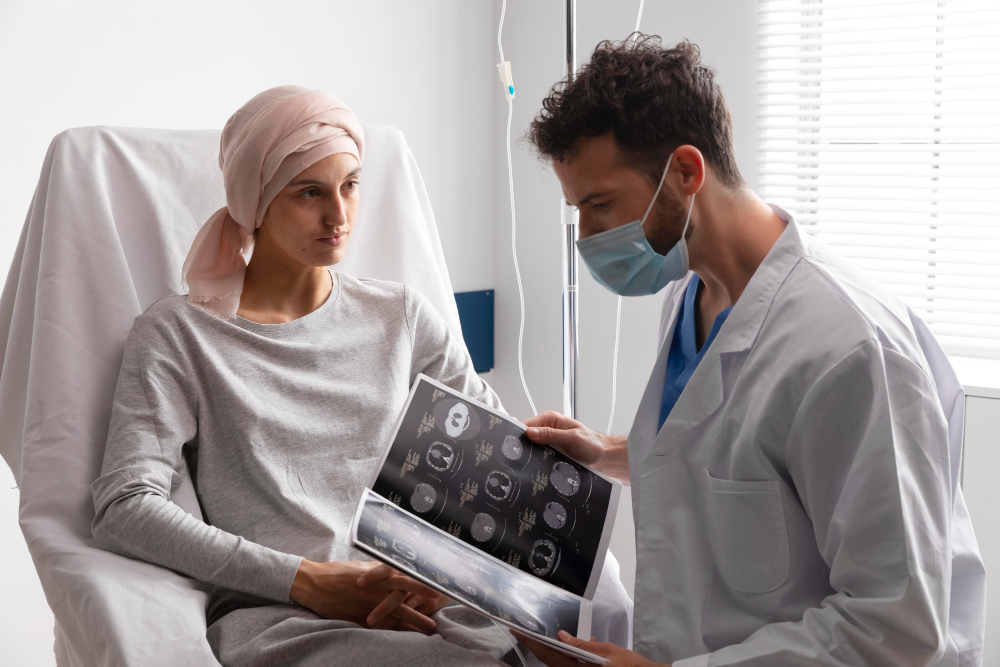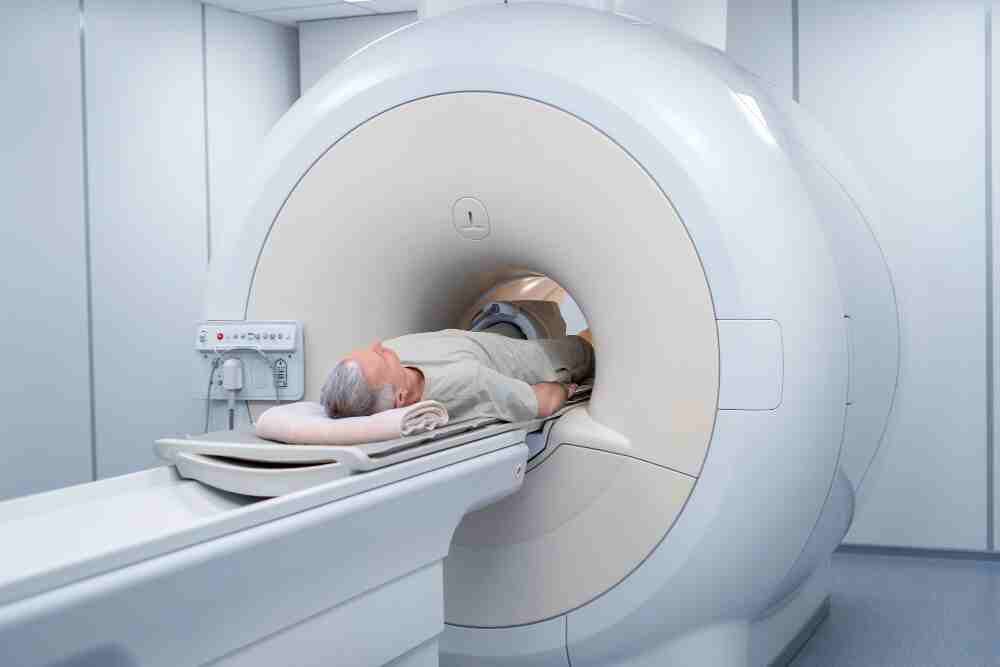Book on Whatsapp
9892101616
What You Need to Know About PET Scans for Cancer Detection
Cancer
Fri Jan 03 2025
PET scans are now a crucial part of cancer diagnosis, staging, and treatment monitoring. These cutting-edge imaging methods provide physicians with a unique perspective on the body's internal workings, enabling them to identify cancer, gauge its spread, and determine how well a treatment is working. Here is a thorough explanation of PET scans and their critical significance in cancer treatment.
How PET Scans Work
A tracer, a small quantity of radioactive material, is injected into the body during a PET scan. Since cancer cells have a higher metabolic activity than normal cells, they tend to absorb more glucose, making it the most widely utilised tracer. By detecting the radiation that the tracer emits, the PET scanner produces finely detailed images that show regions with significant metabolic activity, such as tumours. This enables medical professionals to identify anomalies and evaluate the location, size, and spread of cancer in the body.
Detecting and Staging Cancer
The detection and staging of cancer is one of the main applications of PET scans in cancer care. The procedure of staging involves determining the extent of the cancer's spread throughout the body, including whether it has impacted distant organs or local lymph nodes. PET scans are particularly helpful in detecting concealed tumours or metastases (spread to other parts of the body), which may not be evident with conventional imaging methods like X-rays or CT scans. This is because PET scans offer vital information about the activity of cancer.
Monitoring Treatment Progress
PET scans are also used to track the effectiveness of cancer treatments. Physicians can determine if the cancer is responding to treatment by comparing PET scans taken before and after treatment. When a tumour reduces in size or has decreased metabolic activity, the treatment is working. PET scans can occasionally identify a cancer return before symptoms or other imaging tests indicate any changes, enabling early management.
Benefits of PET Scans
There are numerous benefits to using PET scans for cancer detection and treatment.
PET scans can detect cancer early on, even before other imaging tests pick it up.
Accurate Staging: PET scans assist physicians in creating the most effective treatment plan by demonstrating the degree of cancer spread.
Treatment and Monitoring: Through the use of PET scans, physicians can assess the effectiveness of cancer treatments and make appropriate modifications.
Non-Invasive: PET scans are a less taxing technique on patients' bodies because they are typically rapid and non-invasive.
Potential Risks and Limitations
PET scans are very helpful in the treatment of cancer, but there are some risks and limitations to be aware of. One possible problem is the radiation exposure from the tracer, even though the amount is generally thought to be low and safe. Young children and pregnant women should not undergo PET scans unless necessary. Additionally, PET scans can result in false positives because conditions like inflammation or infections can also cause high metabolic activity that mimics cancer. Finally, very small tumours or those with low metabolic activity may not be detected by PET scans.
Conclusion
PET scans are an essential tool in the fight against cancer because they provide detailed images of the body's internal processes, which aid in early cancer detection, precise cancer staging, and treatment effectiveness monitoring. Although PET scans have certain risks and limitations, they are incredibly beneficial in the treatment of cancer.
Related Tests
Related Packages
Related Blogs

Cancer
How Early Diagnosis Can Improve Cancer Treatment
Cancer treatment outcomes depend heavily on how early the disease is diagnosed. Detecting cancer in its early stages often leads to better survival rates, less invasive treatments, and improved quality of life. Early detection enables timely intervention even before the cancer has spread to other parts of the body, increasing the effectiveness of treatments like surgery and radiation therapy. Regular screenings, awareness of early warning signs, and access to diagnostic tests like colonoscopies, mammograms, and blood tests play a crucial role in identifying that cancer is at a manageable stage.
Methods of Early Diagnosis
Early detection of cancer relies on a variety of diagnostic tools and procedures that help identify the disease at its most treatable stage. Routine screenings such as mammograms, Pap smears, and colonoscopies are essential for detecting cancers like breast, cervical, and colorectal cancer before symptoms appear. Imaging techniques, including CT scans, MRIs, and ultrasounds, allow doctors to view the internal organs and tissues to identify abnormal growths and tumors. Biomarkers and genetic tests can detect early cellular changes and assess an individual's risk for certain cancers, aiding in personalized treatment planning. In cases where abnormal cells are found, biopsies are performed to confirm the diagnosis and determine the cancer type and stage.
Advantages of Early Detection
Early detection of cancer plays a vital role in improving treatment outcomes and long-term health. When cancer is identified at an early stage, it often results in higher survival rates, as the disease is more likely to be localized and treatable. Patients usually require less aggressive treatment, which means fewer side effects and complications compared to advanced-stage interventions. Additionally, early diagnosis can lead to lower treatment costs, as simpler therapies are often more cost-effective than complex, multi-step treatments required for later stages. Patients also benefit from faster recovery and a better quality of life, allowing them to return to normal routines more quickly and with less emotional and physical stress.
Barriers to Timely Diagnosis
Many people delay diagnosis due to fear, stigma, lack of awareness, or poor access to healthcare facilities. These barriers must be addressed through education and better healthcare infrastructure. Fear of cancer often leads individuals to ignore early symptoms, hoping they will resolve on their own. Social stigma can prevent open conversations, especially in communities where discussing illness is taboo. A lack of awareness about the importance of regular screenings and warning signs further contributes to late diagnosis. Moreover, in rural or economically weaker areas, people may not have access to quality healthcare services. Strengthening primary healthcare, training medical staff, and promoting community-based education can bridge these gaps effectively.
Encouraging Preventive Care
Promoting regular screenings, community awareness, and health literacy is essential. Government and healthcare systems must work together to ensure early detection becomes a norm.
Early cancer diagnosis saves lives. It allows for timely treatment, reduces complications, and improves outcomes for patients and their families. By identifying cancer in its initial stages, treatment is often more effective, less invasive, and less costly. It also helps preserve organ function, reduces emotional distress, and supports better long-term recovery and well-being.

Cancer
Empowering Women with Knowledge About Ovarian Cancer
Ovarian cancer is one of the major severe health concerns for women today. A silent interloper often called the "silent killer" because it also creeps in quietly, with symptoms so vague that they are often mistaken for common digestive or menstrual issues.
Bloating, pelvic discomfort, or feeling full too quickly may seem harmless, but when ignored, can lead to delayed diagnosis. However, “forewarned is forearmed.” With increased regular screenings and awareness, women can also rise against this hidden enemy. Knowledge is the power, and when combined with timely medical care, it can turn the tide.
Through the reliable health checkups, like those offered by Manipal TRUtest, women can also catch early signs, seek instant help, and beat the odds. Encouraging open conversations, supporting one another, and removing the fear surrounding cancer can truly save lives. It is time to break the silence, and empower every woman to prioritize her health because prevention is always better than a cure.
Understanding Ovarian Cancer
Ovarian cancer begins in the ovaries, the organs in charge of producing eggs in women. It often goes unnoticed until it spreads to other parts of the body. Common signs include:
- Frequent urination
- Pelvic pain
- Unexplained weight loss or fatigue
- Bloating or swelling in the abdomen
- Feeling full quickly while eating
If you experience these symptoms often, consult your doctor.
Risk Factors
Some women are more at risk than others. The main risk factors are:
- Family history of ovarian or breast cancer
- Endometriosis
- Genetic mutations (BRCA1 or BRCA2)
Knowing your risk helps you stay alert.
Importance of Regular Screening
The regular health checkups, especially after the age of 40, is important. At Manipal TRUtest, you can get access to affordable women's health checkups. These include ultrasound, CA-125 blood test, and consultation with specialists. Early detection leads to better treatment results.
Healthy Lifestyle for Prevention
The healthy lifestyle for prevention is
- Avoiding tobacco
- Discussing preventive options with your doctor if you have a family history
- Eating a healthy diet rich in fruits and vegetables
- Exercising regularly
Emotional Support Matters
The emotional support matters as a cancer diagnosis can be emotionally overwhelming. Women need support from family, friends, and professionals. Talking openly and joining support groups can help reduce anxiety and fear.
Take Action Today
Don't wait for symptoms to get worse. Take charge of your health. Book a women's wellness package at Manipal TRUtest and consult a healthcare expert. Remember, awareness, prevention, and early diagnosis are your best defense against ovarian cancer.

Cancer
The Role of Whole-Body PET Scans in Cancer Diagnosis
Early recognition of cancer is often the key to successful treatment . One of the most powerful tools in modern medicine for early cancer detection is the whole-body PET scan. This advanced imaging technique enables doctors to view cellular activity throughout the body, often revealing disease before physical symptoms appear—offering a clearer picture than many traditional scans.
What is a Whole-Body PET Scan?
A PET scan (Positron Emission Tomography) is a specialized diagnostic testthat helps doctors understand how tissues and organs are functioning. In a whole-body PET scan, the entire body is scanned in a single session, making it easier to detect cancer that may have spread.
During the test:
- A small, safe dose of radioactive tracer is injected into a vein.
- This tracer travels through the bloodstream and is absorbed by cells with high energy usage—like cancer cells.
- The PET scanner captures detailed images, highlighting areas where the tracer accumulates.
How Whole-Body PET Scans Help in Cancer Diagnosis
Cancer cells behave differently than normal cells—they divide rapidly and consume more energy. As a result, they take up more of the radioactive tracer, which causes them to "glow" on the scan. This makes it easier for physicians to:
• Detect cancer early—even before symptoms begin• Determine whether cancer has spread (metastasized)
• Evaluate how well current treatment is working
• Guide biopsy procedures to the most affected area
• Plan surgery or radiation therapy with greater accuracy
A PET scan provides a comprehensive image, assist doctors in more accurate diagnoses and improved treatment plans.
Who Should Consider a Whole-Body PET Scan?
Your doctor may recommend a PET scan if:
- You are undergoing treatment and doctors need to check the response.
- There is a suspicion that cancer has returned after treatment.
- You are showing signs that could indicate cancer.
- There is a need to stage the cancer and find out how far it has spread.
People with a high risk of cancer, such as those with a family history of the disease, may also be advised to undergo a PET scan for early detection.
Is a Whole-Body PET-CT Scan Safe?
Safety is a common concern. PET scans involve a very small amount of radiation, and the benefits of early detection generally far outweigh the risks. However, it's important to inform your healthcare provider if you are pregnant or breastfeeding, as special precautions may be needed.
How to Prepare for Your PET-CT Scan? To get the most accurate results:
- You may need to fast for several hours before the scan (water is usually allowed and encouraged)
- Wear loose, comfortable clothing
- Remove any metal objects like jewelry
- Follow any specific instructions provided by your healthcare team
Whole-body PET-CT scans are a vital tool in the early detection and treatment of cancer. They provide information that cannot be detected with standard scans, allowing physicians to detect disease earlier and treat it more successfully. If your physician recommends it, having a PET scan can be an crucial step toward safeguarding your health and well-being.
